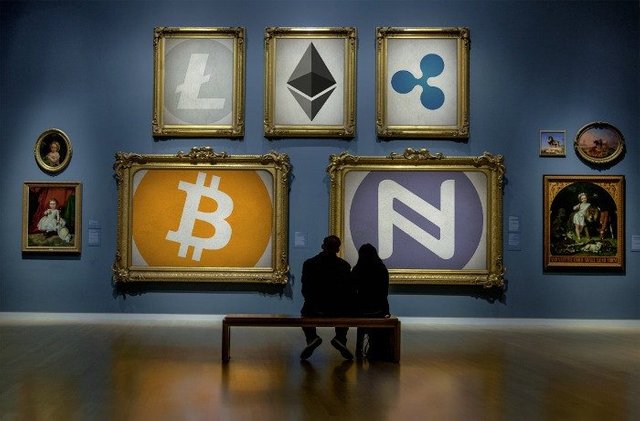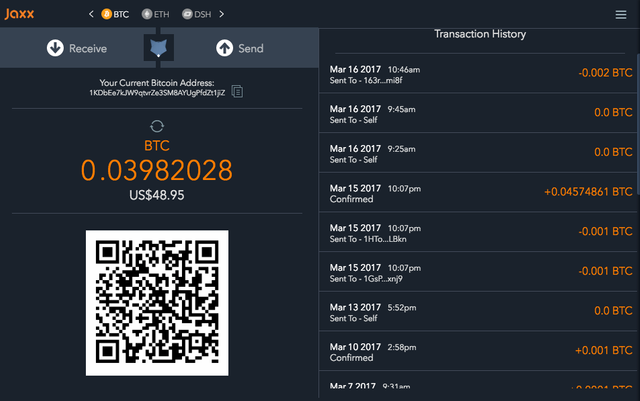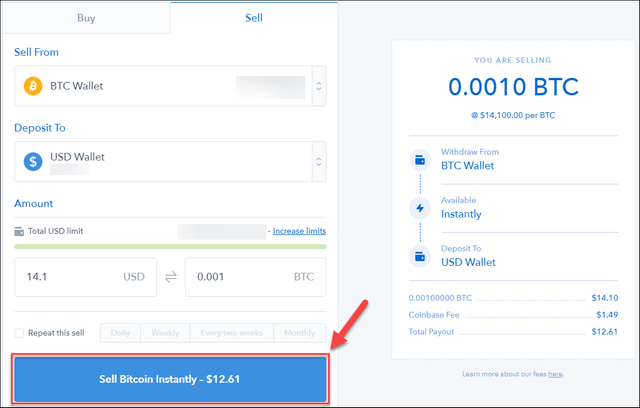How To Sell Your Artistic and Musical Works For Cryptocurrencies! ~ A Step by Step Guide
This isn't just for newbies to the crypto market. Elders come share your advice too!
Are you an artist and want to learn how to make crypto from your art?
(Image from here)
The rise in price of Bitcoin has brought many new faces
to the world of crypto. I have myself come to Steemit to see if there's potential here to promote the artists that have signed up to Artopium.com. Indeed, Steemit is working out to be an excellent opportunity.
However, in my endeavor to bring my fellow artists over to the crypto world, I realized that despite it's lucrative lure, many of my friends and fellow artists are daunted by the complexity as well as the funny sounding lingo.
If you haven't got a clue where to start, this is the perfect article for you.
It's More Like Cash Than You Think
It's much better to think of crypto currencies as cash rather than a credit card. Here's a comparative table showing the similarities and differences between cryptocurrencies and physical cash as well as digital cash such as a credit card or money wire:
| * | Crypto | Physical Cash | Digital Cash |
|---|---|---|---|
| No need for a bank | X | X | _ |
| Anonymous transactions | X | X | _ |
| Accidental loss | X | X | _ |
| Can be stored offline | X | X | _ |
There are a lot of really good articles and videos out there so I'm not going to try to explain the detailed nuances of how cryptocurrencies work. What's important to understand is that cryptocurrencies have many of the same features as cash, and you should be just as guarded with your crypto as you would your cash.
In the land of crypto, everything is decentralized, meaning that there's no central authority figure creating restrictions or rules, but there's also no one to turn to when things go wrong. This is good because it grants economic freedom, but it comes with obvious risks; the same risks you would find storing your money under your mattress. There are no crypto "banks" to store your coins, but there are a number of ways to protect yourself.
Step 1: Choosing A Cryptocurrency
This can either be really easy, or really hard. I'm going to show you the easy way. All you really need to know to make an initial choice is that there are three widely used coins that you could be using for art sales. The other hundreds of coins are still in their infancy.
Steem
In case you didn't know, Steem is the cryptocurrency used on the Steemit platform. Steem is not easily tradeable outside of Steemit.com and so I don't recommend using it for every day art and music sales. However, if the situation should arise, you should consider selling your work directly to a "Steemian" from your personal Steemit account. I've done this and it worked out really well.
Bitcoin
Bitcoin is the most popular and most traded at the time of this writing, but right now Bitcoin transaction fees make any low priced sale infeasible. Fees are as high as $20 per transaction!
Ethereum
Ethereum is second to Bitcoin, and actually is more than just a coin as it allows for something called smart contracts. Ethereum also has high transaction fees.
Litecoin
This is the coin I recommend you use for art, music, fashion, DVD, and book sales. Litecoin was created by MIT, it's open source, and designed to always have low transaction fees. Transactions complete up to 4 times faster than Bitcoin. And more importantly, the Litecoin platform is very stable, robust, and trustworthy. Every Litecoin transaction I've made has gone through smoothly, whereas I have lost Bitcoins during transactions and so have others. You might see traders complain about Litecoin but that is because it has proven to be one of the least volatile cryptocurrencies. It's precisely this lack of volatility that makes Litecoin ideal for day to day transactions.
Other Coins
There are many to choose from, but most are still very volatile, still in their infancy, and do not have as robust of a transaction platform. These coins are very popular among day traders but may not be suitable for every day use just as of yet.
(Image from here)
Step 2: Choosing Your Wallet
The next thing you will need to do to get started in cryptocurrencies is to download a wallet. A "wallet" in this sense is a computer program or smart-phone app that stores your crypto coins. Your wallet is also how you send and receive money to and from other wallets. Your wallet has an address that is used to receive coins. To make a sale using cryptocurrencies you simply need to give this address to the person wanting to send you the coins. It's that simple! No other software is needed.
The wallet you get will depend on the cryptocurrency you want to use. Right now there are hundreds of cryptocurrencies to choose from; Bitcoin, Ethereum and Litecoin being the most used. Here are some free wallets I recommend to use, but you may find one that works better for you. If you think you might be in the position to posses a lot of cryptocurrency or will be making high price transactions than I would recommend buying a hardware wallet instead of downloading a software wallet as they are more secure.
Mycellium Wallet
Mycellium is a Bitcoin wallet. Stay away from this wallet. I lost Bitcoins with this wallet and the customer support is nil.
Electrum Wallet
This is a very secure wallet for Bitcoins. What I like most about the Electrum wallet is that it is very straight forward and easy to set up the master seed. This is the special code that associates your coins with your wallet. If you lose your wallet you can restore your coins to another wallet with the master seed.
Jaxx Wallet
Despite it's name, I think this is the best wallet for beginners and the one I recommend you use to start out. It holds multiple currencies (it actually has a separate wallet for each currency), it has a simple way to back up the master seed, and it shows an accurate transaction history as you wait for your transaction to complete. But Jaxx doesn't hold Steem...
Steem Wallet
The Steem wallet is the most interesting. If you found this article doing an Internet search then welcome to Steemit, a cryptocurrency based social media platform. By signing up to Steemit.com you not only get access to post blogs and make comments, but each of your posts and comments has the potential to earn Steem from other 'Steemians". Your Steemit account is your Steem wallet.
Step 3: Selling
This part is the easiest part. You can accept your cryptocurrency of choice by simply posting the receive address to your wallet. Be sure the receive address you give out is your current address. The address can change from time to time.
Now that you know that, you can get started accepting crypto on Facebook, Reddit, Pintrest, and of course, feel free to sign up to Artopium.com, a website I run for selling art, music, fashion, video, and books, and post your address there too! Keep in mind that by doing this you would be bypassing the 8% commission fee I normally charge to take USD through PayPal and I'm absolutely fine with that! I want to see the use of cryptocurrencies become widespread!
(Image from here)
Step 4: Trade back to USD
OK, you've got your wallet, you've made a sale for some crypto, now what? First, it's important that you should know that a cryptocurrency isn't just a means of getting back to a US Dollar. You can just keep your crypto coins. There are lots of places to spend crypto, and it's generally rising in value, despite this current surge and pullback. The US dollar on the other hand is going down in value. Something to think about.
However, right now, the major grocery stores and gas stations don't accept cryptocurrency (will that change in 2018?) so it's understandable that you might want to change some of it back to US Dollars. This is actually where things get tricky. Keep in mind that you are currently holding a decentralized and anonymous cryptocurrency and wish to trade it for a centralized fiat currency that requires identification. In other words you will need a bank account and all that is required to get one.
Coinbase
There are actually a number of different ways to convert your cryptocurrency to USD, but coinbase is the most trusted and the most reliable. Signing up and getting full access to a Coinbase account is no small task, though. Be prepared to have the Coinbase website request to turn on your webcam so that it can take a picture of both the front and back of your ID as well as a picture of you. Make sure this picture is crystal clear or Coinbase will reject verification and you will have to wait 24 hours to try again. I made pictures before hand which I uploaded from my hard drive.
Fees
Be aware that withdrawing through Coinbase isn't instant and can take a few days and that there are fees. To make any cryptocurrency transaction requires fees that pay the "miners" who are simply people who run the computers that process the transactions. Anybody can be a miner, remember this is decentralized. Right now the miner's fee for sending Litecoin is 0.001 LTC or about $0.25 to $0.30. You will need to pay this fee to move your crypto over to Coinbase. Once your coins are in your Coinbase wallet, you can withdraw to PayPal, or your bank account. Coinbase charges a $2.99 or 4% fee (which ever is higher) for this transfer.
Conclusion
I hope this has helped an artist become inspired to get into the crypto market. There's a lot more money to be made with cryptocurrencies than there is with the fiat dollar as it's an exciting and growing time with lots of potential. If you follow these steps you should find your migration rather easy!
Please upvote if you think this is a helpful article for newbies.
I hope to bring a lot of artistic content creators to Steemit and this article hopefully contains everything they need to make the transition. Thanks for your support!



EDIT: Litecoin was invented by Charlie Lee under the X11/MIT license